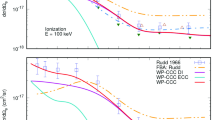Abstract
The absolute differential cross sections of scattering of hydrogen atoms resulting from an electron capture and an electron capture ionization are measured for collisions of 4.5- and 11-keV protons with argon and xenon atoms. The range of scattering angles is 0°–2°. From the scattering differential cross section found experimentally, the probabilities of single-electron capture and electron capture ionization as a function of the impact parameter are calculated. The dependences of the incident particle scattering angle on the impact parameter (deviation function) for interactions with Ar and Xe atoms are calculated in terms of classical mechanics using the Moliére—Yukawa potential to describe the interaction of atomic particles. Analysis is given to the probabilities of electron capture and electron capture ionization versus the impact parameter and to the distribution of the electron density on different electron shells in a target atom versus a distance to the core. It is concluded that only electrons from the outer shell of the target atom are involved in the process of electron capture ionization. The cross section of electron capture ionization is calculated in the proton energy range 5–20 keV.
Similar content being viewed by others
References
M. Abignoli, M. Barat, J. Baudon, J. Fayeton, and J. C. Houver, J. Phys. B 5, 1533 (1972).
V. Sidis, J. Phys. B 5, 1517 (1972).
C. Kubachf and V. Sidis, J. Phys. B 6, L289 (1973).
T. Spranger, M. Zapukhlyak, and T. Kirchner, J. Phys. B 40, 1081 (2007).
L. K. Jonson, R. S. Gao, C. L. Hakes, A. Smith, and R. F. Stebbings, Phys. Rev. A 40, 4920 (1989).
M. Schulz, D. M. Blankenship, S. W. Bross, A. D. Gaus, T. J. Gay, W. Htwe, J. T. Park, and J. L. Peacher, Phys. Rev. A 46, 3870 (1992).
A. Amaya-Tapia, H. Martinez, R. Hernández-Lamoneda, and C. D. Lin, Phys. Rev. A 62, 052718 (2000).
E. Everhart, Phys. Rev. 132, 2083 (1963).
M. Schulz, T. Vajnai, and J. A. Brand, Phys. Rev. A 75, 022717 (2007).
H. Martínez, F. B. Alarcon, and A. Amaya-Tapia, Phys. Rev. A 78, 062715 (2008).
P. N. Abufager, P. D. Fainstein, A. E. Martínez, and R. D. Rivarola, J. Phys. B 38, 11 (2005).
V. K. Nikulin and N. A. Guschina, in Proceedings of the 21st International Conference on Photonic, Electronic and Atomic Collisions (ICPEAC), Sandai, Japan, 1999, p. 586.
V. V. Afrosimov, A. A. Basalaev, V. P. Belik, Yu. V. Maidl, M. N. Panov, and O. V. Smirnov, Fullerene Sci. Technol. 6, 393 (1998).
V. V. Afrosimov, Yu. A. Mamaev, M. N. Panov, and V. Uroshevich, Sov. Phys. Tech. Phys. 12, 512 (1967).
V. V. Afrosimov, Yu. A. Mamaev, M. N. Panov, and N. V. Fedorenko, Sov. Phys. Tech. Phys. 14, 109 (1969).
J. B. H. Stedeford and J. B. Hasted, Proc. R. Soc. London, Ser. A 227, 406 (1955).
Zahlenwerte und Funktion, Atom und Molecular Physik, Herausgegeben Arnold Eucken (Springer, Berlin, 1950), Part 1.
L. D. Landau and E. M. Lifshitz, Course of Theoretical Physics, Vol. 3: Quantum Mechanics: Non-Relativistic Theory (Pergamon, Oxford-New York, 1977).
G. N. Ogurtsov, S. Yu. Ovchinnikov, J. H. Macek, and V. M. Mikoushkin, Phys. Rev. A 84, 032706 (2011).
E. A. Solov’ev, Sov. Phys. Usp. 32, 228 (1989).
W. E. Meyerhof, Phys. Rev. Lett. 31, 1341 (1973).
G. N. Ogurtsov, V. M. Mikushkin, I. P. Flaks, and M. G. Sargsyan, Pis’ma Zh. Tekh. Fiz. 11, 652 (1985).
G. N. Ogurtsov, A. G. Kroupyshev, M. G. Sargsyan, and Yu. S. Gordeev, Phys. Rev. A 53, 2391 (1996).
Author information
Authors and Affiliations
Corresponding author
Additional information
Original Russian Text © V.V. Afrosimov, A.A. Basalaev, G.N. Ogurtsov, M.N. Panov, 2014, published in Zhurnal Tekhnicheskoi Fiziki, 2014, Vol. 84, No. 5, pp. 14–20.
Rights and permissions
About this article
Cite this article
Afrosimov, V.V., Basalaev, A.A., Ogurtsov, G.N. et al. Cross sections of electron capture and electron capture ionization versus the impact parameter in collisions of a proton with multielectron atoms. Tech. Phys. 59, 642–648 (2014). https://doi.org/10.1134/S106378421405003X
Received:
Published:
Issue Date:
DOI: https://doi.org/10.1134/S106378421405003X



